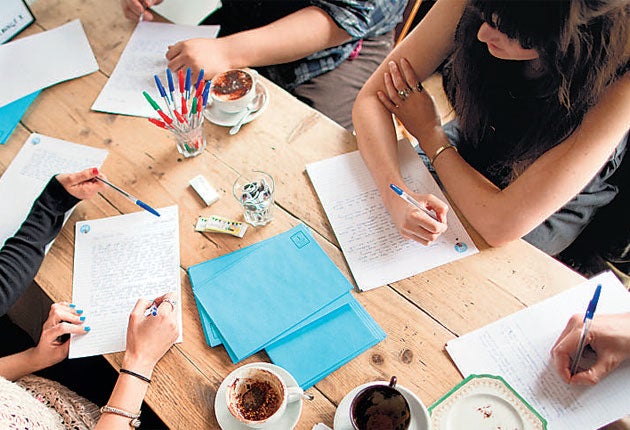Sales boom for pens and paper points to 'snail mail' revival
Surge in stationery sales as Britons increasingly opt for the personal touch over phone or email

Email, text and Twitter were said to be the final nails in its coffin. But as with Mark Twain – a great exponent of the art – reports of the death of letter writing have been greatly exaggerated. Increasingly, people are forgoing the gratification of instant electronic communication for a slower, more personal approach – letter writing is experiencing a revival, and the art of saying thank you is central to its resurgence.
Retailers are reporting increased sales of "snail mail" stationery, including writing sets and fountain pens. They claim the trend for handwritten correspondence is a reaction against electronic communication and part of a wider resurgence in home-made crafts.
With sales of writing paper at John Lewis soaring 79 per cent year-on-year, Clare Northwood, the group's stationery buyer, said there was a "return to people handwriting letters and notecards, offering a more personalised touch". Increased entertaining at home because of the economic downturn could be behind a 20 per cent rise in sales of "thank you" notelets, she said. "It is easier to ping off an email but it is more meaningful to send a thank you card, particularly if someone cooked for you and has gone that extra mile."
Children's writing sets featuring well-known characters are also performing well: sales of Hello Kitty products have risen by 62 per cent in the past 12 months, she said.
Annette Sharp, managing director of the Bristol-based online retailer Papernation, said: "Parents see letter writing as a way of encouraging their children's writing skills without sitting them down to homework. It's a real-life way of encouraging writing skills in children.
"I think it is part of a wider hand-made and back-to-basics approach, appreciating the smaller things in life," she said. "People are a little bit fed up of being bombarded by technology. And it's actually quite nice to sit down and write a note or letter and take time over it. People see letter writing as a way of expressing their personality."
Decorative and embossed designs have become popular, with people buying rubber stamps and stickers to add their own creative touch. "It becomes a piece of art from one friend to another," she said.
Retailers have also reported increased sales of handwriting equipment, with sales of fountain pens up 70 per cent. This surge includes sales of expensive models such as the Mont Blanc Diamond Pen, as customers choose products that make handwriting more enjoyable.
London's City Lit, the largest adult education centre in Europe, has increased its calligraphy courses from six to nine for this coming September, due, it said, to "overwhelming demand".
The joy of getting letters prompted a copywriter, Claire Medcalf, 29, to set up Letter Lounge – a space for people to socialise and write letters. Its success over the past six months took her by surprise, leading her to increase the number of events to meet demand. Most of those attending are in their twenties.
"The only people I get handwritten letters from now are my grandparents," she said, "but I used to write letters to friends at school and things like that. Everyone likes getting letters but people don't really write them any more. I thought if I created an event where it was the main focus, people would take the time to do it."
Rules of letter writing
Liz Wyse, an 'etiquette adviser' for Debrett's, says:
As a general rule, a thank-you letter should be written within a week to 10 days of receipt of a present. If you are thanking a host, try to respond within a week.
A thank-you letter should be handwritten and sent by post, usually first class, or delivered by hand. Never use an office franking machine.
If you are thanking someone for a present, refer to it specifically, and make a positive comment – about its appropriateness, usefulness, attractiveness ("Thank you for the scarf – the olive green is an excellent choice, as it will match my new winter coat").
It is appropriate for parents to respond on behalf of their children before they are able to write. Children should write their own thank yous, however, as soon as they can.
Children should also be encouraged to make a detailed comment about a present ("Thank you for the teddy you gave me for my birthday. I have named him Edward").
When thanking someone after an event, the form of the invitation signals the appropriate format of a thank you. Engraved invitation cards require a formal thank you letter. If you have been invited by phone or email, you can reply in kind.
Join our commenting forum
Join thought-provoking conversations, follow other Independent readers and see their replies
Comments